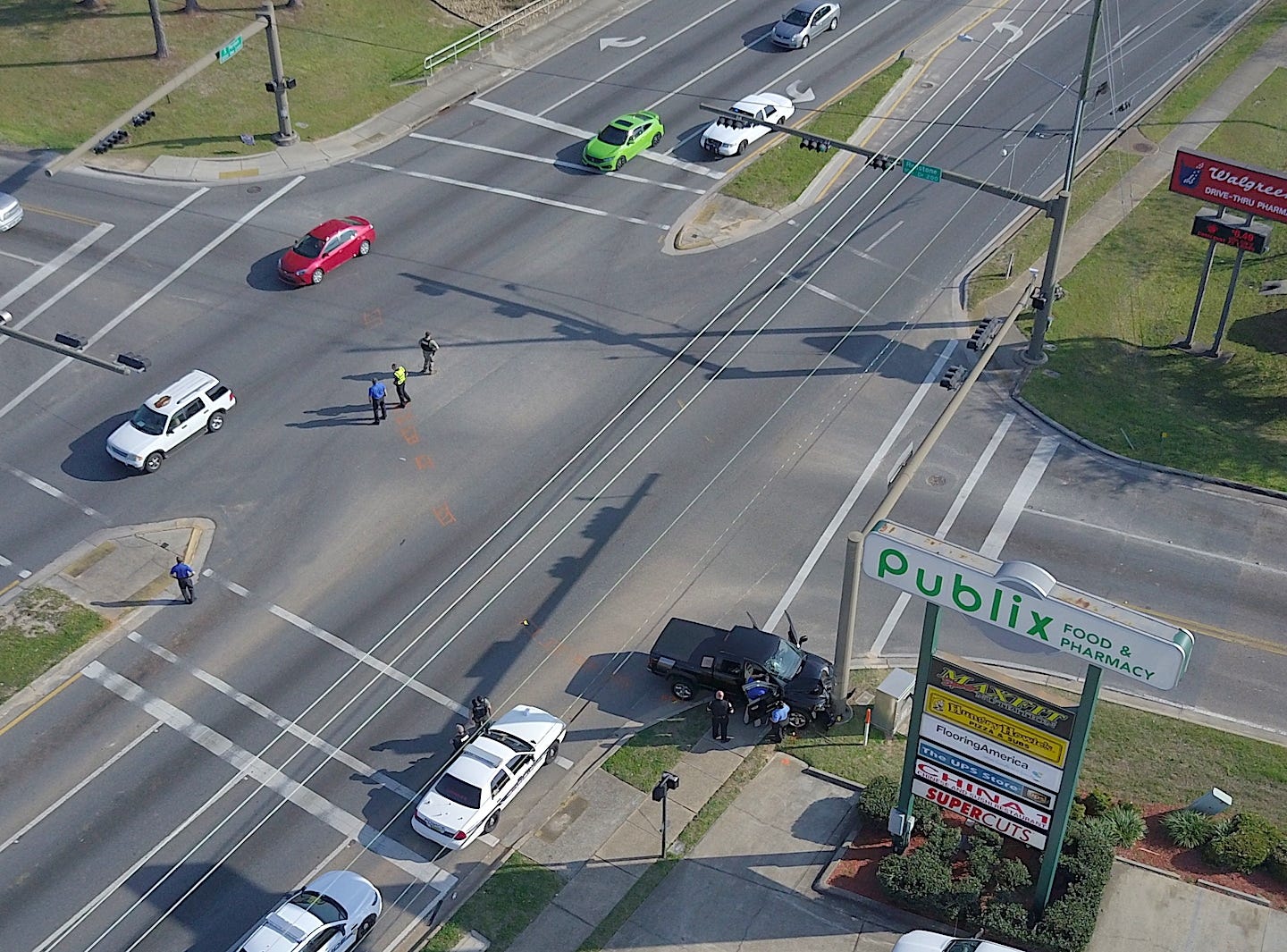![On March 9, the driver of this Dodge pickup truck struck a pedestrian and then crashed into a traffic signal pole, lower right center, while attempting to turn left onto Redstone Avenue West by completely crossing Ferdon Boulevard from the northbound outside turn lane. [MARIO WERTH/ADVANCED AERIAL OPERATIONS]](http://127.0.0.1/wordpress/wp-content/uploads/2022/01/ghows-DA-4c70f6d3-d0bf-7413-e053-0100007fd2c9-0faefbf7.jpeg)
CRESTVIEW — Several recent car vs. pedestrian accidents resulted from inattention by either the pedestrians or the drivers, Crestview Police Chief Tony Taylor said.
Social media posts immediately called for more street lighting and crosswalks.
What’s really needed, Taylor said, is more attention when walking along or driving on the city’s streets, especially on busy thoroughfares such as State Road 85/Ferdon Boulevard.
“All of these recent incidents involve people who just weren’t paying attention,” Taylor said.
Since March, five pedestrians and a bicyclist have been hit on Ferdon, resulting in one death and several victims with serious injuries.
• March 9: A woman waiting to cross the street at the crosswalk was struck on the sidewalk by a Ferdon Boulevard driver who swerved across five lanes of traffic to turn west from the eastbound Redstone Avenue turn lane.
• March 12: A man believed to be standing in Ferdon Boulevard near Griffith Street was hit in the dark during a heavy downpour and killed.
• March 29: Two women were struck when they stood in the inside northbound lane of Ferdon Boulevard with their backs to nighttime traffic near Robinson Avenue to look at a dead dog in the road.
• April 2: A bicyclist was struck by a northbound car when she tried to cross Ferdon Boulevard from Cracker Barrel Road.
• April 9: A woman whom several witnesses said was engrossed in her phone tried to cross Ferdon Boulevard near Duggan Avenue and was struck by a southbound driver. Taylor implored pedestrians and motorists to put distractions such as cellphones away and be more observant.
“Two thousand pounds of steel coming at you is gonna hurt,” Taylor cautioned pedestrians. “Don’t depend on the drivers to see you.”
What happens when a pedestrian is hit by car?
1. Distribution of injuries and sequence of contact
Studies show that most of the pedestrian collisions involve frontal impacts. The sequence of events in a frontal impact is:
• The car bumper strikes either the leg or knee-joint area. This is followed by a thigh to hood edge contact.
• The lower extremity of the body is accelerated forwards, and the upper body is rotated and accelerated relative to the car.
• The pelvis and thorax are struck by the hood edge and top, respectively.
• The head will hit the hood or windscreen (at a velocity which is almost equal to that of the striking car)
• The victim then falls to the ground
The point of first contact by the car hitting the pedestrian will vary depending on the height of the car and as well as the height of the pedestrian. For instance, a modern raised vehicle may hit the head of a child pedestrian because he or she is short.
2. Factors influencing severity of injury
Usually, it is the direct impact with the striking car that causes most serious injuries, not due to the impact of the pedestrian being thrown to the road.
The severity of injuries to the head, brain, thorax, pelvis and extremities is influenced by
• Car impact speed
• Type of vehicle
• Stiffness and shape of the vehicle
• Nature of the front (bumper height, hood height and length, windscreen frame)
• Age and height of the pedestrian
• Standing position of the pedestrian relative to the vehicle front
Source: Review of Injury biomechanics in car-pedestrian collisions. Report to European Passive Safety Network.
The Crestview Police Department recommends these safety tips:
• Don’t text and drive. It’s illegal as well as unsafe.
• Don’t text when walking across or along a busy street.
• Walk a bicycle across busy streets, don’t ride it.
• When on foot, stay out of traffic lanes. They’re for vehicles only.
• Cross only at marked crosswalks, and only when signals are green.
• Turning motorists must yield to pedestrians in marked crosswalks.
• At two-lane road intersections, pedestrians in marked crosswalks have the right of way.
Pedestrian safety tips

This article originally appeared on Crestview News Bulletin: Crestview PD addresses rash of car-pedestrian accidents
